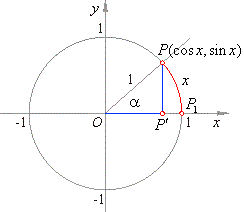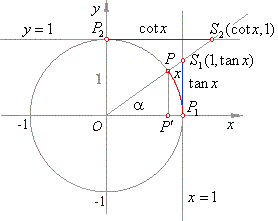|
| Trigonometry |
|
|
|
|
|
Trigonometric
Functions |
 Definitions of
trigonometric functions
Definitions of
trigonometric functions |
 Periodicity of
trigonometric functions
Periodicity of
trigonometric functions |
|
|
|
|
|
|
| Definitions of
trigonometric functions |
|
Let x
be an arc of the unit circle measured counterclockwise from
the
x-axis. It is at the same time the circular measure of the
subtended central angle
a as is shown in the below figure.
|
| In accordance with
the definitions of trigonometric functions |
| in a right-angled
triangle, |
| - the sine of an angle
a
(sina)
in a right triangle is the ratio
of the side opposite the angle to the
hypotenuse. |
| - the
cosine of an angle
a
(cosa) in a
right triangle is the ratio of the side adjacent to it to the hypotenuse. |
| Thus, from the
right triangle OP′P,
follows |
| sinx
= PP′
The sine of arc x
is the ordinate of the arc |
|
endpoint. |
| cosx
= OP′ The cosine of arc
x
is the abscissa of the arc |
|
endpoint. |
|
 |
|
|
| The tangent of an angle
a
(tana)
in a right triangle is the ratio of the lengths of the opposite to the adjacent side. |
| The cotangent is defined as reciprocal of the tangent,
thus |
 |
| From the similarity of the triangles
OP′P
and OP1S1, |
 |
|
 |
|
| Hence, the definition of the tangent function in the unit
circle, |
| tanx
= P1S1
The tangent of an arc x
is the ordinate of intersection of the second or terminal side (or its |
|
extension) of the given angle and the tangent line x =
1. |
| From the similarity of the triangles,
OP′P
and OP2S2, |
 |
|
| cotx
= P2S2
The cotangent of an arc x
is the abscissa of intersection of the second or terminal side (or its |
|
extension) of the given angle and the tangent
y
= 1. |
It is obvious from the definitions that the tangent function is not defined for arguments
x
for which cos x =
0,
as well as the cotangent function is not defined for the arguments for which
sin x = 0. |
|
| Periodicity of
trigonometric functions |
| After the argument (arc)
x
passes through all real values from the interval 0
< x < 2p or after the terminal side
of an angle turned round the origin for an entire circle, trigonometric or circular functions will repeat their
initial values. |
| As the terminal point
P
of an arc continue rotation around a unit circle in the positive direction passing over
the initial point P1 , it takes next values from the interval
2p
<
x < 4p, then the values from the interval
4p
< x < 6p and so on. |
| On the same way we can examine the rotation of the terminal point
P of an arc
x in the
negative (clockwise) direction, when it will pass through the values from the
intervals, 0 to
-2p, from
-2p
to -4p, and so on. |
| It follows that the argument
x can take any
value, |
| x
= arad
+ k · 2p,
k
= 0, ±1,
±2,
±3,
. . .
or x
= a°
+ k · 360°, k
Î
Z. |
| that is, every real value between
-
oo
and +
oo. |
| Particularly, for
k = 0, i.e., during the first rotation the value of
argument is x
= arad. |
| While the arc endpoint continues rounding over the starting point the trigonometric functions will, in
every interval of length
2p (i.e., from
2p to
4p, from
4p to
6p,
. . . , or from
0 to
-2p, from
-2p to
-4p,
. . . ) take the same values in the same order they took in the first interval
[0,
2p]. |
| Functions which have the characteristic to take the same values while their argument changes for all integral
multiples of a constant interval (or a constant
increases in amount called increment) we call
periodic functions, and this constant interval we call
period. |
| Hence, we say that trigonometric functions are periodic functions of
x, so that |
|
f (x) = sin x
and
f (x)
= cos x of
the period P
= 2p, |
| while
functions, f
(x)
= tan x
and f
(x)
= cot x of
the period P =
p. |
|
The periodicity of trigonometric functions show the
identities,
|
| |
sin
(a
+ k · 2p)
= sin a
and cos
(a
+ k · 2p)
= cos a,
k
Î Z |
|
|
| |
tan
(a
+ k · p)
= tan a
and cot
(a
+ k · p)
= cot a,
k
Î Z |
|
|
|
|
|
|
|
|
|
|
|
|
|
|
|
|
|
|
| Pre-calculus
contents C |
|
|
 |
|
| Copyright
© 2004 - 2020, Nabla Ltd. All rights reserved. |